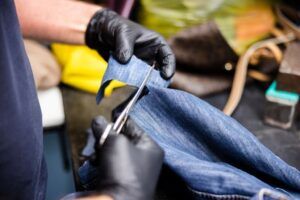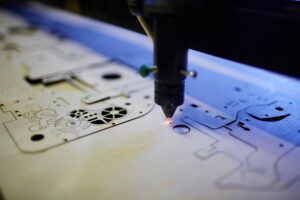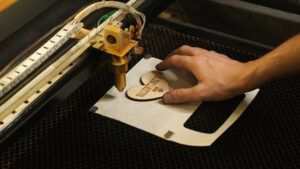Taking some safety precautions when working with a laser engraver machine is important if you want to avoid harming yourself in easily preventable ways. Laser engravers are generally very safe and don’t require much training to learn how to use them properly.
But if you don’t pay attention to what you’re doing, you can easily cause damage – both to yourself and the machine. We’ve prepared some safety tips for beginners below, so make sure to familiarize yourself with the list before starting your first project.

What Harm Can a Laser Engraver Cause?
When used correctly, laser engravers are quite safe and it’s difficult to harm yourself unless you go out of your way to do something unexpected. Every good model on the market comes with various safety measures to minimize the risk of harm to the user. You should always go through the instructions of a new laser engraver to find out how it works and what risks it poses to your health.
Some common examples of health hazards associated with using a laser engraver include:
- Pneumatic pressure – laser engravers have various moving parts controlled by powerful mechanisms. If your body gets in the way, the machine will usually not stop automatically, at least not right away. This makes it dangerous to reach inside a working laser engraver without turning it off properly first.
- Thermal hazards – these machines work by heating materials to very high temperatures. Exposing your body to those temperatures can cause permanent damage, and in some cases can even threaten your life. That’s why every good laser engraver comes with safety measures that prevent you from interfering with the machine while it’s in operation.
- Blinding – you should never stare directly into a laser beam, and that goes double for the kinds of lasers used in laser engraver machines. A regular pocket laser pointer is already powerful enough to potentially blind a person, but with a laser engraver, damage to your eyes is pretty much guaranteed even after a very brief contact.
- Vapors and fumes – laser engravers produce harmful vapors during their operation. It’s important to work with these machines in well-ventilated environments and pay attention to the exhaust port to ensure that it’s not clogged. A laser engraver’s exhaust must always be vented outside of the building and into open air, never directly into another enclosed space.
- Debris – working with a laser engraver produces tiny debris. Normally, excess material accumulates in specifically designated compartments inside the engraver, from where it can be safely removed after you’re done working. If you don’t clean your laser engraver regularly, debris might eventually start flying out of it.
Safety Tips for Laser Engraver Users
Now that you know how a laser engraver could potentially hurt you, here are some tips to minimize the risk and ensure that you’re as safe as possible when operating your machine.
Familiarize Yourself with the Laser Engraver Before Using It for the First Time
Always go through the supplied instructions carefully and scan them page by page. Never assume that you know how to use one laser engraver model just because you’ve already worked with a different one.
For example, some laser engravers only support a limited range of materials that can be engraved. Familiarize yourself with that list and never use materials that are not approved by the manufacturer.
Understand Laser Classes
Lasers come in several classes, with the danger associated with their use increasing with each one. You should never stare directly into a laser beam regardless of its class. For classes 3 and 4, you must also avoid direct exposure to the beam. Class 4 lasers are particularly dangerous – they can burn your skin even after a brief contact!
Always Use Glasses or a Shield



Always use protective eyewear/headwear when working with a laser engraver. You risk harming your eyes without laser engraver safety glasses. A laser engraver safety shield will also prevent various other problems such as debris flying into your face and potentially cutting you.
Some laser engravers come with protective gear in their packaging, while others don’t. Don’t assume that the manufacturer will provide you with everything you need to have in order to use the engraver safely. Safety goggles and shields are relatively inexpensive compared to what you’ve already spent on the engraver, so go the extra mile and invest in gear that will keep you safe.
Work in a Well-ventilated Area
Working with a laser engraver in an enclosed space without ventilation is dangerous. Many models allow you to vent them to the outside through an exhaust hose, but you should avoid relying on that feature exclusively.
Instead, make sure that you operate your laser in a well-ventilated area that allows fumes to escape easily without any extra effort on your part.
Never Leave the Laser Engraver Running Unattended
Once you’re done working with your laser engraver, shut it off completely and take out any parts that the manufacturer requires you to. Never leave a laser engraver running while you’re not in the room, even for a brief period.
Otherwise, the laser might start burning something and cause a fire. Alternatively, fumes could accumulate in the room and knock you out as soon as you enter.
Wear Gloves When Working with Sharp Objects
If you’re working on engraving projects with lots of fine details, wearing gloves is a good idea. This will protect you from small, sharp objects which can cut your skin.
It’s not just about handling the items you’re engraving – you must also be careful about debris flying out and hitting you, as we mentioned above in the section about wearing facial protection.
Keep a Fire Extinguisher Around You



Even if you take all necessary precautions, sometimes your laser engraver could start a fire due to an unexpected malfunction. Always keep a fire extinguisher in an easily accessible spot.
Learn how to use it too! Using a fire extinguisher is not at all complicated if you’ve read the instructions, but if you have to read them for the first time while you’re panicking in the middle of a growing fire, you can easily make a mistake and make things worse.
Clean the Laser Engraver Regularly
Make sure there are no physical obstructions in the laser engraver after each use. This includes small debris, leftover engraving materials, and tools you may have used during the engraving process. Clean the engraver thoroughly at least once a week to prevent anything from accumulating in it.
Don’t Make Modifications to the Laser Engraver Unless You Know Exactly What You’re Doing
Modifying your laser engraver can seem tempting, especially if you have a cheaper model which you want to upgrade to something fancier. But this is something you should never do if you don’t have specific experience in the field. Any physical modifications to a laser engraver come with a risk, especially if you change anything about its safety features.
One very common beginner mistake is to attempt to disable protective features in order to accelerate the workflow. You should absolutely never do this. These features exist for a reason, and no matter how experienced you may feel with using the engraver, you should never go down that path.
Never Operate a Damaged Laser Engraver
If your laser engraver is damaged, stop using it immediately and unplug it completely. Take it to a professional to have it repaired and don’t resume your work until the problem has been resolved. Even if it seems like a minor issue, you never know what could have happened beneath the surface.
Conclusion
Now that you’re familiar with some safety tips for laser engraver users, all that’s left to do is to ensure that you actually put them into practice. After you’ve worked with your engraver for a while, you’ll probably start feeling more confident about it and you’ll develop certain habits for operations you perform commonly.
This can eventually lull you into a false sense of security which you should absolutely never fall for. Always follow all safety procedures as closely as possible, and don’t underestimate problems if you spot any during your work.





